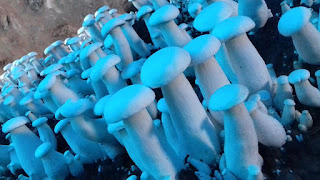Love Mushrooms? Choose among them
"Without leaves, without buds, without flowers, yet they form fruit. As a food, as a tonic and as a medicine, mushroom is the wonderful of nature." - S.T.Chang in Chang and Miles (1990).

Hippocrates, a well-known Greek physician of the Age of Pericles and known as the 'Father of Western Medicine', first mentioned the medicinal value of mushrooms around 400 B.C. The Aztecs considered mushrooms as 'God's flesh' and the Romans regarded them as 'Food of God', which was served occasionally during the celebration of festive spirit.
The Pharaohs of Ancient Egypt believed that mushrooms had magical powers, while the Chinese treasured mushrooms as healthy food, the 'elixir of life' and used them to cure several diseases.
During the reign of Alexander the Great in Ancient Greece, he provided the warriors with mushrooms, which were exported from different parts of the world. The people of Greece believed that mushrooms were potent symbols that provided strength to the warriors in the battle.
The intoxicating drink 'soma', one of the energy potions used by the Aryas, was the extract of a toadstool named fly agaric- Amantia muscaria.

Mushroom, aka toadstool, is the fleshy, spore-bearing fruiting body of a fungus. Today, we will take a look over one of the chief mushroom varieties, called milky mushroom (Calocybe indica). Let's ponder through the pages of wonders...
Calocybe indica, also known as 'Dudh Chatta' in the regions of West Bengal, is an edible mushroom which is native to India. The etymology of the term 'Dudh Chatta' is derived from Bengali. 'Dudh' is a Bengali term meaning milk and 'Chatta' means umbrella. Milky mushrooms resemble the white umbrellas. It is nutrient-rich and the world sees these medicinal values are the cure to many diseases.
Taxonomic Classification of C.indica
Kingdom
|
Fungi
|
Division
|
Basidiomycota
|
Class
|
Agaricomycetes
|
Order
|
Agaricales
|
Family
|
Lyophyllaceae
|
Genus
|
Calocybe
|
Species
|
indica
|
Milky mushrooms can replace other tropical mushrooms such as Pleurotus app., etc. The reason for this is that it has high protein content and has a good biological efficiency compared to other mushrooms. These mushrooms are widely used as a food supplement and high protein content and low-fat level are the reasons behind the larger consumption of this mushroom in a malnourished country, like India.
Nutritional Value of Milky Mushroom (in 100 gm)
Energy
|
46.56 Kcal
|
Carbohydrate
|
6.70 g
|
Protein
|
4.26 g
|
Fat
|
0.68 g
|
Alanine
|
28.96 g
|
Cystine
|
18.18 g
|
Glycine
|
17.78 g
|
Thiamin
|
6.20 mg
|
Riboflavin
|
7.50 mg
|
Niacin
|
10 mg
|
Vitamin C
|
12.82 mg
|
Calcium
|
10.40 mg
|
| Iron |
10.86 mg
|
Potassium
|
415.6 mg
|
Phosphorus
|
622.6 mg
|
Moreover, the list goes on. As you can see, the nutritional values of milky mushroom that are mentioned above are well known. Let us see some trace elements.
Copper
|
1.9 mg
|
Sodium
|
11.8 mg
|
Zinc
|
1.47 mg
|
Fibre
|
3.24 g
|
Tannin
|
1.80 mg
|
Polyphenol
|
3.70 mg
|
| Ash | 2.30 g |
The other chief varieties of mushrooms include oyster and button mushrooms. Here is the comparison chart of nutritional values among these mushrooms.






Comments
Post a Comment